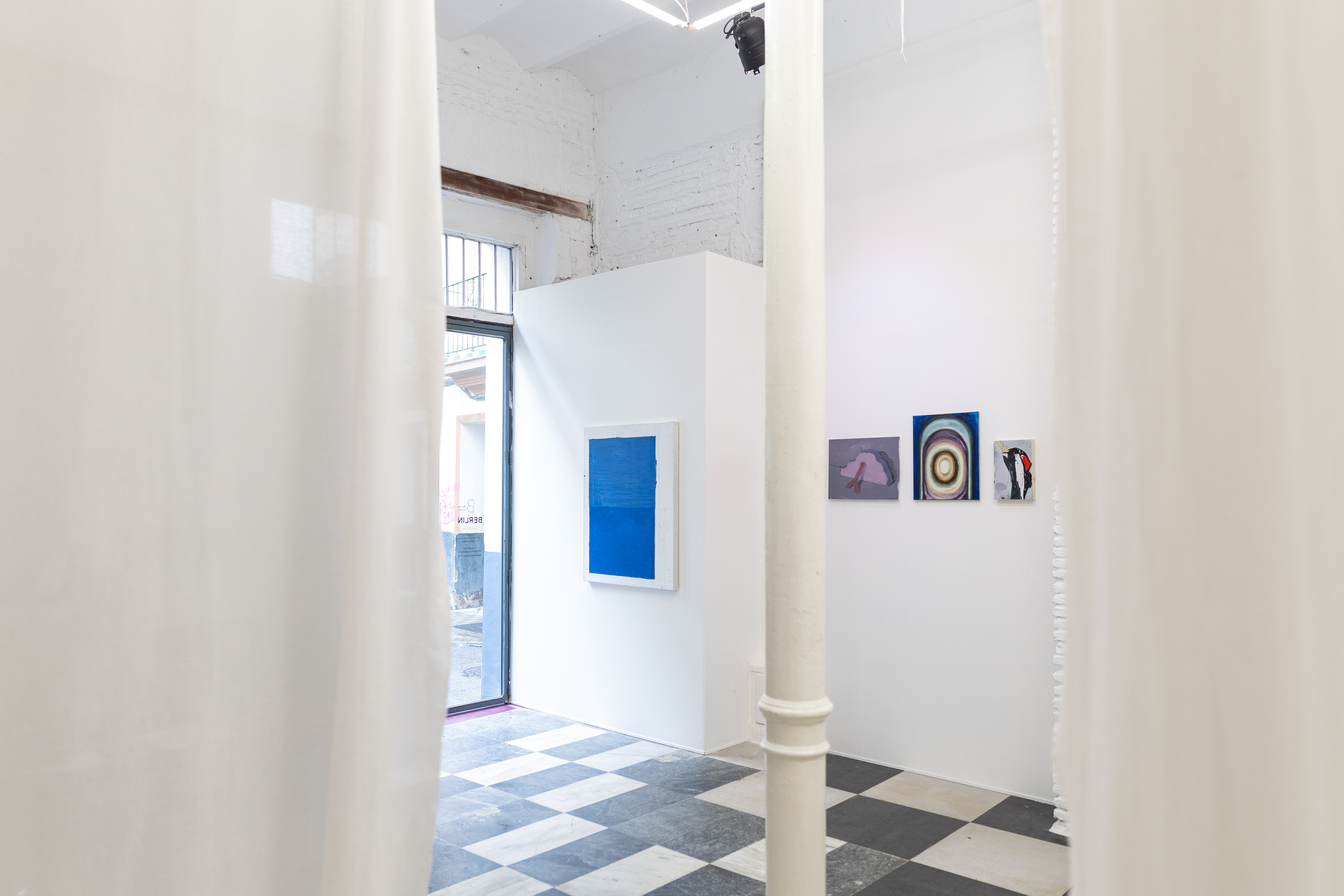UNA CAPILLA PROPIA
MIQUEL PONCE, DIEGO LOZANO, VICTOR GONZÁLEZ Y GUILLERMO VELASCO, BERLÍN GALERÍA, SEVILLA 2024
![]()
![]()
![]()
![]()
![]()
![]()
![]()
![]()
![]()
![]()
![]()
![]()
![]()
![]()
![]()
![]()
Una capilla propia
A 45 centímetros de la obra, uno no está frente a la pintura sino dentro de ella.
«Yo» no es más que un término práctico que se refiere a alguien sin existencia real. Manarán mentiras de mis labios, pero quizás un poco de verdad se halla mexclada entre ellas; os corresponde a vosotras buscar esta verdad y decidir si algún trozo merece conservarse. Si no, la echaréis entera a la papelera, naturalmente, y os olvidáis de todo esto. - Virginia Wolf (Un habitación propia)
Rothko, como pintor de la intuición y los trastornos (desasosiegos, alegrías, paroxismos, euforias), no disfrutaba de seguridades de ninguna índole. Expresaba lo primordial, lo primitivo, y es muy posible que una parte de su pesimismo radicase en la ambición de expresar, precisamente, cómo es ese puente que, de forma movediza, enlaza lo bello con lo sublime. Cuando uno mira sus cuadros y los ve, se percata de que él conocía muy bien la diferencia entre lo bello y lo sublime. - Alberto Garrandés (En la capilla Rothko)
Sirvan de base el trabajo de ambos artistas, Wolf en la escritura y Rothko en la pintura, para aclaranos la sensación de desintimidad, desgarro y pasión que el creador como tal debe apercibir a la hora de mostrar su obra, ¿o mostrarse a sí mismo?. Este leitmotiv tomará forma en tiltulo expositivo en cuatro espacios independientes, cerrados y etéreos, donde cada artista, con su modo particular de expresión, deberá abordar al espectador desde el silencio de la obra, agredir la mirada para hacer comprender que los procesos pictóricos, y su resultado final, no conllevan un fin meramente estético, sino una confrontación con la propia realidad del artista.
De este modo, la elección de estos cuatro artistas deviene por su modo de tratar la pintura, obviando su fin estético. Cada uno a su modo realza sus propios conceptos propios con un trazo personal yuna manera de expresión que los hace individuales ala hora de ver la pintura, ymostrarla al espectador para que el mismo se sienta envuelto en un universo plástico que conjuga con lo más íntimo de de la percepción.
Tomar el espacio y convertir la pintura en un auto de fe.
Jesús Barrera
-
A Chapel of one's own
At 45 centimeters from the artwork, one is not in front of the painting but inside it.
"I" is no more than a practical term that refers to someone without real existence. Lies will pour from my lips, but perhaps a bit of truth will be mixed among them; it is up to you to seek out this truth and decide if any piece deserves to be kept. If not, you will naturally throw it all in the trash and forget about it entirely. - Virginia Woolf (A Room of One's Own)
Rothko, as a painter of intuition and turmoil (unease, joys, paroxysms, euphoria), did not enjoy any kind of certainty. He expressed the primordial, the primitive, and it is very possible that part of his pessimism stemmed from his ambition to convey, precisely, the nature of that bridge, shifting and unstable, that links the beautiful to the sublime. When one looks at his paintings and truly sees them, it becomes clear that he understood the difference between the beautiful and the sublime. - Alberto Garrandés (In the Rothko Chapel)
Let the works of both artists—Woolf in writing and Rothko in painting—serve as a foundation to clarify the sense of exposure, rupture, and passion that the creator must perceive when presenting their work—or perhaps themselves. This leitmotif will take shape as an exhibition title spanning four independent, enclosed, and ethereal spaces. Each artist, in their unique mode of expression, will confront the viewer from the silence of their work, challenging the gaze to make it understood that the pictorial processes, and their final outcome, are not merely aesthetic ends but a confrontation with the artist's own reality.
Thus, the selection of these four artists arises from their approach to painting, bypassing its aesthetic purpose. Each, in their own way, emphasizes their distinct concepts with personal strokes and an expressive method that makes them unique when it comes to viewing painting and presenting it to the spectator. The aim is for the viewer to feel enveloped in a plastic universe that resonates with the innermost layers of perception.
To claim the space and transform painting into an auto-da-fé.
Jesús Barrera















